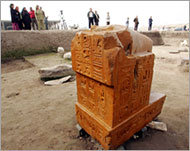Egypt uncovers Ramses II statues
Archaeologists have discovered a pharaonic sun temple with large statues believed to be of King Ramses II under an outdoor marketplace in Cairo.

Zahi Hawass, head of Egypt’s Supreme Council of Antiquities, said the partially uncovered site is the largest sun temple to be found in the capital’s Aim Shams and Matariya districts, where the ancient city of Heliopolis – the centre of pharaonic sun worship – was located.
Among the artefacts was a pink granite statue weighing about four tonnes whose features “resemble those of Ramses II”, Hawass said.
Also found was a 1.5m-high statue of a seated figure with hieroglyphics that include three cartouches with the name of Ramses II, the council said in a statement.
The green pavement stones of the temple’s floor were also uncovered.
More discoveries possible
An Egyptian team working with the German Archaeological Mission in Egypt discovered the site under the Souq al-Khamis, a market in eastern Cairo, Hawass said.
 |
|
Among the artefacts found are |
He said that “the market has to be removed” as archaeologists excavate the entire site.
“Other significant discoveries might be waiting to be excavated now, and compensation will be paid to the shop owners.”
Hawas said: “We are planning to make the whole area as a tourists and archaeological site, maybe after two years.”
King Ramses II, who ruled Egypt for 66 years from 1270 to 1213 BC, had erected monuments up and down the Nile with records of his achievements, as well as building temples – including Abu Simbel, erected near what is now Egypt’s southern border.
Ancient city
Numerous temples to Egypt’s sun gods – particularly the chief god Ra – were built in ancient Heliopolis.
But little remains of what was one the ancient Egyptians’ most sacred cities, since much of the stone used in the temples was later plundered.
The area is now covered with residential neighbourhoods, close to a modern district of Cairo called Heliopolis.
Heliopolis was a region known in ancient times for sun worship and where the council says a calendar based on the solar year was invented.